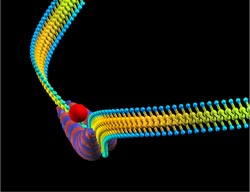MIT closes in on bionic speed

See caption below
Theory could result in faster artificial muscles
Robots, both large and micro, can potentially go wherever it’s too hot, cold, dangerous, small or remote for people to perform any number of important tasks, from repairing leaking water mains to stitching blood vessels together.
Now MIT researchers, led by Professor Sidney Yip, have proposed a new theory that might eliminate one obstacle to those goals – the limited speed and control of the “artificial muscles” that perform such tasks. Currently, robotic muscles move 100 times slower than ours. But engineers using the Yip lab’s new theory could boost those speeds – making robotic muscles 1,000 times faster than human muscles – with virtually no extra energy demands and the added bonus of a simpler design. This study appears in the Nov. 4 issue of the journal Physical Review Letters.
In this case, a robotic muscle refers to a device that can be activated to perform a task, like a sprinkler activated by pulling a fire alarm lever, explains Yip, a professor of nuclear engineering and materials science and engineering.
In the past few years, engineers have made the artificial muscles that actuate, or drive, robotic devices from conjugated polymers. “Conjugated polymers are also called conducting polymers because they can carry an electric current, just like a metal wire,” says Xi Lin, a postdoctoral associate in Yip’s lab. (Conventional polymers like rubber and plastic are insulators and do not conduct electricity.)
Conjugated polymers can actuate on command if charges can be sent to specific locations in the polymer chain in the form of “solitons” (charge density waves). A soliton, short for solitary wave, is “like an ocean wave that can travel long distances without breaking up,” Yip adds. (See figures.) Solitons are highly mobile charge carriers that exist because of the special nature (the one-dimensional chain character) of the polymer.
Scientists already knew that solitons enabled the conducting polymers to conduct electricity. Lin’s work attempts to explain how these materials can activate devices. This study is useful because until now, scientists, hampered by not knowing the mechanism, have been making conducting polymers in a roundabout way, by bathing (doping) the materials with ions that expand the volume of the polymer. That expansion was thought to give the polymers their strength, but it also makes them heavy and slow.
Lin discovered that adding the ions is unnecessary, because theoretically, shining a light of a particular frequency on the conducting polymer can activate the soliton. Without the extra weight of the added ions, the polymers could bend and flex much more quickly. And that rapid-fire motion gives rise to the high-speed actuation, that is, the ability to activate a device.
To arrive at these conclusions, Lin worked from fundamental principles to understand the physical mechanisms governing conjugated polymers, rather than using experimental data to develop hypotheses about how they worked. He started with Schrödinger’s equation, a hallmark of quantum mechanics that describes how a single electron behaves (its wave function). But solving the problem of how a long chain of electrons behaves was another matter, requiring long and complex analyses.
This research was funded by Honda R&D Co. and the Defense Advanced Research Projects Agency/Office of Naval Research. Yip and Lin’s collaborators on the work are Professor Ju Li at Ohio State University and Professor Elisabeth Smela at the University of Maryland.
In Figure 1, a soliton (blob with red and blue stripes) moves along a conducting polymer chain (aqua and yellow for hydrogen and carbon). The soliton blob causes a localized bend in the chain. The traditional way to make polymer actuate is to dope the material with an ion such as sodium, represented by the red dot. New MIT research has suggested another way, shown in figure 2, is to shine light of a specific frequency (h‡), on the conducting polymer. The polymer in figure 2 is a chain (neutral charge, green) that is naturally curved before exposure. The effect of light (h‡ frequency) is to create positive charges (red) in a localized area. The positive charges enhance the chemical bonding between the polymer’s units and straighten out the curved chain in that area. (This straightening occurs where the red and blue striped lobe appeared in Figure 1. The lobe can move along the polymer chain rapidly.) Figures courtesy Yip lab, MIT
Media Contact
More Information:
http://www.mit.eduAll latest news from the category: Physics and Astronomy
This area deals with the fundamental laws and building blocks of nature and how they interact, the properties and the behavior of matter, and research into space and time and their structures.
innovations-report provides in-depth reports and articles on subjects such as astrophysics, laser technologies, nuclear, quantum, particle and solid-state physics, nanotechnologies, planetary research and findings (Mars, Venus) and developments related to the Hubble Telescope.
Newest articles

How marine worms regenerate lost body parts
The return of cells to a stem cell-like state as the key to regeneration. Many living organisms are able to regenerate damaged or lost tissue, but why some are particularly…

Nano-scale molecular detective
New on-chip device uses exotic light rays in 2D material to detect molecules. Researchers have developed a highly sensitive detector for identifying molecules via their infrared vibrational “fingerprint”. Published in Nature…

Novel CAR T-cell therapy
… demonstrates efficacy and safety in preclinical models of HER2-positive solid tumors. The p95HER2 protein is found expressed in one third of HER2+ tumors, which represent 4% of all tumors….



